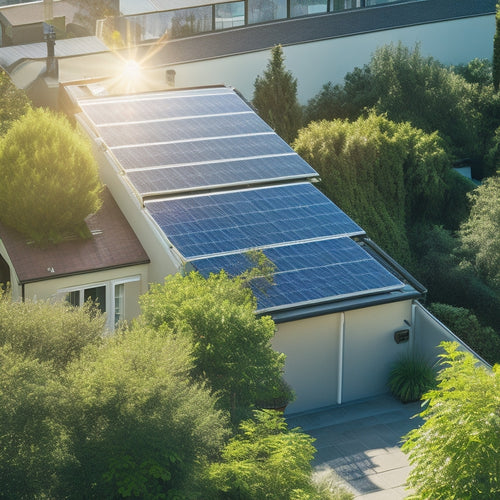
How to Boost Energy Efficiency With Commercial Solar Equipment
Share
By integrating commercial solar equipment into your business operations, you can considerably reduce your energy expenditures and carbon footprint while increasing energy independence and potential financial returns. To enhance energy efficiency, start by evaluating your energy needs and designing a customized system that incorporates high-efficiency solar panels, advanced tracking systems, and optimized energy storage solutions. Regular monitoring and maintenance are essential to guarantee peak performance and address any discrepancies. By considering your unique energy demands and leveraging available financial incentives, you can access the full potential of commercial solar equipment and take an important step towards a more sustainable, cost-effective energy strategy that will benefit your business in the long run.
Key Takeaways
- Assess energy needs through audits and peak usage analysis to identify optimization opportunities and tailor energy solutions effectively.
- Optimize solar panel performance by choosing high-efficiency panels, proper system orientation, and implementing tracking systems to follow the sun's movement.
- Implement energy harvesting and storage solutions, such as solar batteries, to store excess energy and contribute to energy resilience strategies.
- Regularly monitor and maintain the system to ensure peak performance, detect minor problems, and enable system upgrades for improved performance and lifespan.
- Analyze ROI and explore financial incentives, such as government rebates and utility partnerships, to reduce overall investment expenses and highlight long-term savings.
Understanding Commercial Solar Benefits
As a business owner, you're likely no stranger to the pressure of keeping operational costs in check. One effective way to reduce expenses is by utilizing the power of commercial solar equipment. By doing so, you can take advantage of financial incentives, reduce your environmental impact, and increase your energy independence.
Solar technology offers a reliable alternative to traditional grid alternatives, providing long-term savings and scalability to meet your growing energy needs.
Commercial solar equipment is a viable option for businesses of all sizes, with installation costs decreasing over the years. As the technology continues to evolve, you can expect even more benefits in the future.
Choosing the Right Solar Panels
When selecting solar panels for your commercial installation, you'll want to take into account three key factors: panel efficiency ratings, durability and warranty, and compatibility and integration.
These factors will impact the overall performance and return on investment of your solar energy system.
Panel Efficiency Ratings
With solar panels being a significant investment for your business, selecting the right ones is essential to maximize energy efficiency. When choosing a solar panel, you'll encounter various panel efficiency ratings. These ratings indicate how well a panel converts sunlight into electricity.
Efficiency ratings typically range from 15% to over 22%. Higher efficiency ratings mean more power per unit area, resulting in lower installation costs and more energy generated per hour of sunlight. For instance, a 400-watt panel with a 20% efficiency rating will produce more power than a 350-watt panel with a 15% efficiency rating, despite being the same physical size.
Recent advancements in panel technologies have led to significant efficiency improvements. Bifacial panels, for example, can absorb light from both the front and back sides, increasing energy output.
Other innovations, such as half-cut cells and multi-busbar designs, also contribute to higher efficiency ratings. When evaluating solar panels, consider the efficiency rating in conjunction with other factors like cost, durability, and warranty to guarantee you're getting the most energy-efficient solution for your business.
Durability and Warranty
Your solar panel investment's lifespan relies heavily on the durability and warranty of the equipment. A durable solar panel system can withstand various environmental conditions, guaranteeing ideal energy output over its lifetime.
When selecting commercial solar equipment, evaluate the material longevity of the panels, frames, and mounting systems. Look for high-quality materials that can resist degradation, corrosion, and weathering.
Some key aspects to evaluate are:
- Weather resistance: Can the equipment withstand extreme temperatures, humidity, and weather conditions?
- Material quality: Are the materials used in the construction of the panels and mounting systems durable and long-lasting?
- Certifications and compliance: Do the equipment and materials meet industry standards and certifications, such as UL and IEC?
A thorough warranty coverage is also essential, as it provides protection against equipment failures, repairs, and replacements.
Confirm the warranty covers the entire system, including the panels, inverters, and mounting systems, and offers adequate coverage duration and transferability.
Compatibility and Integration
Selecting the right commercial solar equipment is critical to guaranteeing a seamless and efficient energy harvesting process. You need to evaluate system compatibility and equipment integration to enhance performance and guarantee a smooth grid connection.
When choosing your solar panels, verify they're compatible with your existing electrical infrastructure and can integrate with other components, such as inverters and monitoring systems. This will allow you to maximize energy production and minimize downtime.
Look for equipment with open communication protocols, allowing for seamless data exchange between components. This will facilitate performance enhancement and allow real-time monitoring of your system's performance.
Additionally, assess the equipment's grid connection capabilities, verifying it can synchronize with the grid frequency and voltage. This will allow you to feed excess energy back into the grid and offset your energy consumption during periods of low solar production.
Assessing Your Energy Needs
You need to understand your current energy usage to determine the right size and type of commercial solar equipment for your business.
To do this, you'll want to analyze your energy consumption patterns, including peak usage hours, seasonal fluctuations, and overall energy demand.
Current Energy Usage
Evaluating energy needs begins with a thorough examination of current energy usage patterns. This involves conducting energy audits to identify areas of inefficiency and opportunities for improvement.
By analyzing your energy usage trends, you'll gain a better understanding of your energy needs and identify potential areas for cost savings.
Some key aspects to contemplate when examining your current energy usage include:
-
Peak usage times: When are your energy usage peaks occurring, and what systems or equipment are driving these spikes?
-
Energy-intensive systems: Which systems or equipment are consuming the most energy, and are there opportunities to optimize their performance?
-
Inefficient practices: Are there any inefficient practices or habits contributing to energy waste, and how can these be addressed?
Energy Consumption Patterns
Energy consumption patterns play an essential role in evaluating your energy needs, as they provide useful insights into your facility's energy usage habits. By analyzing your energy consumption patterns, you can identify peak energy periods, off-peak hours, and opportunities for load shifting. This information is vital in optimizing your energy usage and reducing consumption.
Conducting energy audits helps you understand your facility's energy usage patterns, including seasonal variations and consumption trends. These audits can reveal opportunities for behavioral changes and energy conservation measures. By identifying areas of inefficiency, you can implement demand response strategies to reduce energy consumption during peak periods.
Understanding your energy consumption patterns also enables you to develop targeted strategies for energy conservation. By analyzing your usage patterns, you can identify opportunities to reduce energy waste, optimize energy-intensive processes, and implement energy-efficient technologies.
Designing an Efficient System
With a clear understanding of commercial solar equipment's benefits, it's essential to design an efficient system that maximizes energy production while minimizing costs.
You'll want to guarantee your system is optimized to meet your specific energy needs. This involves analyzing your energy consumption patterns and identifying areas where energy can be saved.
To achieve system optimization, consider the following key factors:
-
Load balancing: Confirm that your system can handle peak energy demands without overloading, which can lead to reduced efficiency and increased maintenance costs.
-
System configuration: Properly configure your system to guarantee that each component is working together seamlessly to maximize energy production.
-
Energy storage integration: Incorporate energy storage solutions to store excess energy generated during the day for use during periods of low energy production.
Maximizing Energy Harvesting
As you move forward with your commercial solar equipment installation, maximizing energy harvesting becomes a vital consideration. To achieve this, you'll want to focus on optimizing your system's performance through advanced technologies and careful planning.
Solar tracking systems, for instance, can increase energy output by up to 45% by adjusting the panels' angle and orientation to capture the most sunlight. Energy optimization software can also help you fine-tune your system's performance by analyzing weather patterns, shading, and other environmental factors.
Proper system orientation is also essential, as it can affect energy production by up to 20%. Additionally, shading analysis can help you identify areas where trees or buildings may cast shade on your panels, allowing you to adjust their placement accordingly.
Installation techniques, such as using high-efficiency inverters and minimizing wiring losses, can also enhance energy harvesting. By monitoring your system's performance analytics, you can identify areas for improvement and optimize your energy output.
Energy Storage and Backup
Integrate a reliable energy storage and backup system to guarantee your commercial solar equipment installation operates at peak performance, even during periods of low sunlight or grid outages. This assures you can continue to power your business operations without interruption, minimizing losses and maximizing productivity.
By incorporating energy storage and backup solutions, you can:
-
Utilize solar battery advantages to store excess energy generated during the day for use during peak demand periods or at night
-
Implement energy resilience strategies to protect your business from grid outages and guarantee continuous operations
-
Opt for sustainable backup solutions that reduce your reliance on fossil fuels and lower your carbon footprint
With a hybrid systems integration, you can seamlessly switch between grid power, solar power, and energy storage to optimize your energy usage and reduce costs.
This allows you to achieve off-grid capabilities, reducing your dependence on the grid and enhancing your energy independence.
Monitoring and Maintenance Tips
Your commercial solar equipment installation requires regular monitoring and maintenance to guarantee peak performance, maximize energy efficiency, and prevent potential issues.
You need to keep a close eye on your system's performance tracking to identify any discrepancies or anomalies. This can be achieved through routine inspections, which should be scheduled as part of your maintenance plan. By doing so, you can detect and address minor problems before they escalate into major issues.
Regular maintenance also enables you to take advantage of system upgrades, which can improve your equipment's performance and extend its lifespan.
Employ software solutions to streamline data analysis and troubleshooting techniques, assuring that your system operates at ideal levels. This proactive approach won't only assure energy efficiency but also contribute to equipment longevity.
Incentives and ROI Analysis
One of the most notable advantages of investing in commercial solar equipment is the plethora of incentives available to offset the upfront costs.
You can tap into various tax credits, financing options, and incentive programs that can greatly reduce your investment expenses.
-
You can claim tax credits of up to 30% of the total project cost, which can be carried forward for multiple years.
-
You can investigate financing options that allow you to pay for the system over time, reducing the initial financial burden.
-
You can take advantage of government rebates and utility partnerships that provide additional funds for your project.
Frequently Asked Questions
Can Solar Panels Be Installed on Rooftops With Skylights or Vents?
You can install solar panels on rooftops with skylights or vents, but you'll need to contemplate skylight considerations during rooftop installation, ensuring a secure and watertight seal around obstructions to maintain energy efficiency and prevent water damage.
How Do Solar Panels Perform in Extreme Weather Conditions?
"When in doubt, prepare for the worst" - a mantra that applies to solar panels in extreme weather. You'll be relieved to know that high-quality solar panels are designed to withstand harsh conditions, with durability built to minimize the impact of extreme weather on energy production.
Are There Any Specific Certifications for Commercial Solar Installers?
You'll want to verify your commercial solar installer meets industry standards, holding certifications like NABCEP (North American Board of Certified Energy Practitioners) or UL (Underwriters Laboratories) to assure their installer qualifications and adherence to rigorous industry standards.
Can Solar Energy Systems Be Integrated With Existing HVAC Systems?
You can integrate solar energy systems with existing HVAC systems, optimizing energy efficiency through solar system integration, which allows you to utilize renewable energy and reduce your reliance on traditional HVAC systems for hvac optimization.
What Is the Average Lifespan of Commercial Solar Equipment?
You're likely to get 25-30 years of service from your commercial solar equipment, depending on solar panel longevity and regular equipment maintenance, ensuring a strong ROI and reduced energy costs over its lifespan.
Conclusion
As you utilize the power of commercial solar equipment, your business will soar like a bird taking flight, leaving energy inefficiencies in the dust. With the right system design, energy storage, and maintenance, you'll release significant savings and a reduced carbon footprint. By following these steps, you'll be well on your way to maximizing energy efficiency and reaping the rewards of a sustainable future.
Related Posts
-

How Solar Panels Reduce Electricity Bills
Solar panels can drastically cut your electricity bills by utilizing sunlight to generate your own energy. This decre...
-

Integrating Smart Technology for Energy Savings
Integrating smart technology into your home is a transformative factor for energy savings. Smart thermostats give you...
-

Energy-Efficient Heating and Cooling Appliances
Energy-efficient heating and cooling appliances can cut your energy bills markedly. By opting for models with high En...


